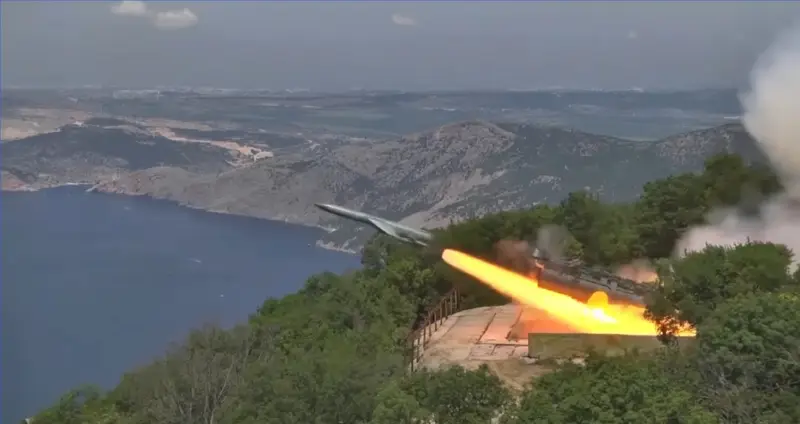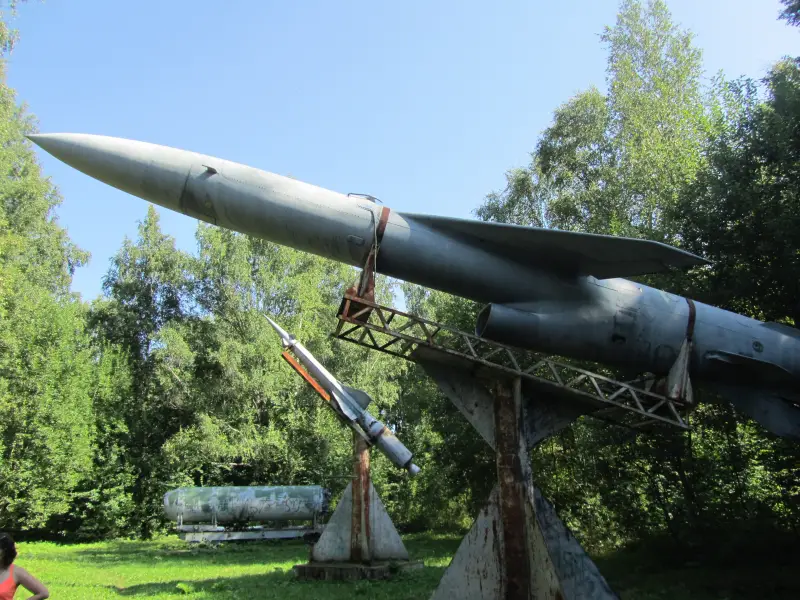The use of P-35 anti-ship missiles by mobile DBK "Redut" and stationary DBK "Utyos" against ground targets on the territory of Ukraine

Firing from a stationary coastal missile system (BRK) "Utyos" in Crimea in July 2019
The Ukrainian publication Defense Express reported that on January 18, Russia used P-35 anti-ship missiles (ASM) for the first time against ground targets located on the territory of Ukraine. Presumably, the P-35 anti-ship missile could have been fired by the launcher of the Redut mobile coastal missile system or the launcher of the stationary Utes coastal missile system, located in Crimea.

Wreckage passed off by Defense Express as the remains of the X-35 anti-ship missile
It is impossible to establish the reliability of this information, since the condition of the wreckage, presented by Defense Express as the wreckage of the P-35 anti-ship missile, does not allow them to be unambiguously determined, and Russian official structures do not comment on the situation. At the same time, the possibility of using P-35 anti-ship missiles using the Redut or Utes missile launchers cannot be completely ruled out, especially since this looks like a completely justified decision.
Anti-ship missiles P-35, DBK "Redut", DBK "Utes"
Adopted by the Navy fleet (Navy) of the USSR in 1962, the P-35/P-6 (4K44) anti-ship missile system was developed by OKB-52 as a development of the P-5 (4K34) anti-ship missile system, intended for armament of submarines. If the P-35 anti-ship missiles were to be used from surface ships and coastal missile systems, then the P-6 anti-ship missiles were intended for use from diesel-electric submarines (diesel-electric submarines) of Project 651 and nuclear submarines (SNB) of Project 675, located on the surface. The carriers of the P-35 anti-ship missiles were Project 58 cruisers, equipped with two quadruple rotary launchers SM-70.

Carriers of the P-6 anti-ship missiles - diesel-electric submarines of project 651 (left, top) and project 675 submarines (left, bottom), as well as the carrier of the P-35 anti-ship missiles - cruiser of project 58 (right)
A little later, ground-based launchers were developed - the mobile DBK "Redut" and the stationary DBK "Utes". If the P-6 underwater anti-ship missile carriers, as well as the P-35 surface anti-ship missile carriers, are no longer in service, then the Redut ballistic missile launchers, according to data for 2022, remained in service with the Russian Armed Forces about 8 units.

Self-propelled gun SPU-35B BRK "Redut". Image by Mil.ru
Also in 2016, the stationary DBK “Utyos”, located in Crimea, was restored, earlier, during the period of “independence” of Crimea, abandoned by the Armed Forces of Ukraine (AFU) and falling into disrepair.

PU DBK "Utes"
For their time, anti-ship missiles of the P-35 family were quite advanced weapons. The rocket was launched from a sealed launch container using two solid rocket boosters. The flight speed of the P-35 missile, equipped with a KRD-26 turbojet engine, reached 1,8 M (M-speed of sound), the flight altitude varied from 400 to 7 meters, and the range, based on the flight profile, ranged from 000 to 100 kilometers .
On the final section, up to 20 kilometers long, the flight altitude could be up to 100 meters. The warhead could be conventional, weighing 560 kilograms, or nuclear, with a yield of about 20 kilotons.
During the cruising phase, the flight adjustment of the P-35 anti-ship missiles could be carried out by the operator using a radio command guidance system; before approaching a target (group of targets), the operator selected targets based on data from the active radar homing head (ARLGSN) of the missile, after which the guidance to the selected target was carried out by the missile independently with the help of ARLGSN. Potentially, the P-35 anti-ship missiles could also attack ground targets at the operator’s commands, but it is doubtful that the effectiveness of such attacks with conventional warheads could be high (if a nuclear warhead were used, the P-35 anti-ship missiles would be more than effective against any type of target).
For surface targets, the P-35 anti-ship missiles could also be used in a fully autonomous mode, but in this case the effectiveness dropped significantly, since these anti-ship missiles could not independently select targets.

Anti-ship missiles P-35. Image by Vadim Indeikin
In 1982, the modernized 3M44 Progress anti-ship missile system was put into service, whose flight range increased to 460 kilometers. The 3M44 Progress anti-ship missile system had increased noise immunity of the communication channel with the ship, and the altitude of the final flight segment, up to 50 kilometers long, was reduced to 25 meters.
It can be assumed that in our time the effectiveness of the P-35 anti-ship missiles, even in the modernized version 3M44 Progress, is insufficient to destroy modern warships, and therefore anti-ship missiles of this type were used by the Russian Navy only to simulate enemy anti-ship missiles during exercises.
However, the conduct of the Russian Special Military Operation (SVO) in Ukraine makes us look at many things differently, including prospects for the use of seemingly outdated weapons systems.
P-35 anti-ship missiles in Ukraine
Is it possible to use P-35 anti-ship missiles in Ukraine?
Yeah why not? When firing anti-ship missiles with a range of about 300–460 kilometers from stationary launchers of the Utyos DBK, Odessa, Nikolaev, Kherson, Krivoy Rog, and Dnepr are in the affected area.

Estimated reach zones of the P-35 anti-ship missiles at a range of about 300–460 when launched from stationary launchers of the Utes ballistic missile system
In the case of the use of mobile launchers of the Redut DBK, the affected area will increase as much as the close the Redut DBK launchers can be moved to the line of combat contact (LCC). In this case, Kharkov, Kyiv and other Ukrainian cities are in the affected area, and most importantly, transport facilities on the Dnieper.

Estimated reach zones of P-35 anti-ship missiles (for a range of about 460 kilometers) when launched from Redut mobile missile launchers
The main question is in what capacity (if used) are the P-35 anti-ship missiles used?
The firing accuracy of a conventional, unmodified P-35 anti-ship missile is not sufficient to effectively engage ground targets, of course, unless we are talking about the use of a tactical nuclear charge. Thus, the only option for using unfinished P-35 anti-ship missiles is to use these missiles to open or distract enemy air defense systems. Not the most effective use case, but it is better than if these missiles are used for Russian Navy exercises to repel attacks by anti-ship missiles, which the enemy simply does not have (the enemy is now using low-flying, stealthy anti-ship missiles, the analogue of which the P-35 is certainly not).
On the other hand, we have an example of the Ukrainian Armed Forces, which used modified Soviet jet unmanned aerial vehicles Tu-141 “Strizh” and Tu-143 “Flight” to carry out strikes on Russian territory, while the accuracy of these UAVs was brought almost to the accuracy of modern ones high-precision cruise missiles (CR).
It can be assumed that the P-35 anti-ship missiles and the 3M44 Progress anti-ship missiles can be modified in a similar way, after which they can be effectively used against pinpoint ground targets on the territory of Ukraine.
A powerful warhead weighing about 500 kilograms, combined with a fairly high flight speed, potentially makes it possible to use these anti-ship missiles for destruction of transport structures on the Dnieper, to whom for some reason we have an inexplicable “loyalty”. This also includes the so-called decision-making centers in Ukraine, which for some inexplicable reasons are also taboo for striking them with long-range precision weapons – but it’s time to pay Ukraine for the attacks on our cities.
Considering that information on the use of various types of weapons in the Northern Military District zone is often closed, it is impossible to completely exclude the possibility of using P-35 anti-ship missiles and 3M44 Progress anti-ship missiles in a modified form for high-precision destruction of ground targets, but so far this information has not been confirmed, however, as well as the very fact of using these anti-ship missiles.
The warhead of the P-35 anti-ship missile system could potentially be modified by turning it into a cluster one, including the use of incendiary combat elements - we have previously discussed the possibility of such modification in relation to the X-22 anti-ship missile system in the material “Blow for blow: cluster warheads on long-range precision weapons”.
Cluster warheads, including those with incendiary warheads, can be used against area targets, such as power plants and electrical substations, data centers, fuel storage facilities and many others.

A cluster incendiary warhead does not require high accuracy, but can cause significant damage to the enemy
In general, there will be work for the modified P-35 anti-ship missiles in the Northern Military District zone.
Why not use the Kh-35 missile system, the Kalibr complex missile system, the Oniks anti-ship missile system, the Kh-101/Kh-22 anti-ship missile system, the Iskander OTRK or hypersonic missiles of the Kinzhal complex instead of the outdated P-32 anti-ship missiles?
Because the question is not “instead”, but “together”. In this war, the number of long-range precision weapons will never be sufficient, so it is necessary to modernize and refine everything we have, including the P-35 anti-ship missiles, which can become a formidable weapon after a relatively minor modification of the control/guidance system.
Conclusions
At the moment, there is no official confirmation that the P-35 anti-ship missiles were used in the Northern Military District zone, but there is also no reliable refutation of this. If the P-35 anti-ship missiles were used, it is unknown whether they were used only to open or distract enemy air defense systems, or whether they were modified to hit pinpoint ground targets.
Considering the power of the warhead and the flight speed of the P-35 anti-ship missiles, the best solution would be to modify them to hit particularly important targets as part of the joint use of various types of long-range precision weapons, such as the Kh-101 missile, the Kalibr complex missile, and the Oniks anti-ship missile ", anti-ship missiles Kh-22/Kh-32, OTRK "Iskander" and hypersonic missiles of the "Dagger" complex.
In addition to the refinement and use of the P-35 anti-ship missiles, we should not forget about the imminent end of the careers of such anti-ship missiles as “Basalt”, “Vulcan” and “Granit”, the development and use of which should be in many ways comparable to those required by the P-35 anti-ship missiles . We previously spoke about the refinement and use of these anti-ship missiles against ground targets in the material "Disposal by shot: the use of anti-ship missiles "Basalt", "Volcano" and "Granit" to destroy especially important targets on the territory of Ukraine".

Anti-ship missiles "Basalt", "Vulcan" and "Granite" are waiting in the wings...
As the offensive potential of the Ukrainian Armed Forces dries up, they will pay more and more attention to striking deep into the territory of our country. It is necessary not just to snap back, but to ensure a qualitative and quantitative increase in the number of strikes delivered by long-range, high-precision weapons against targets located deep in the territory of Ukraine, and for this, all means are good.
Information